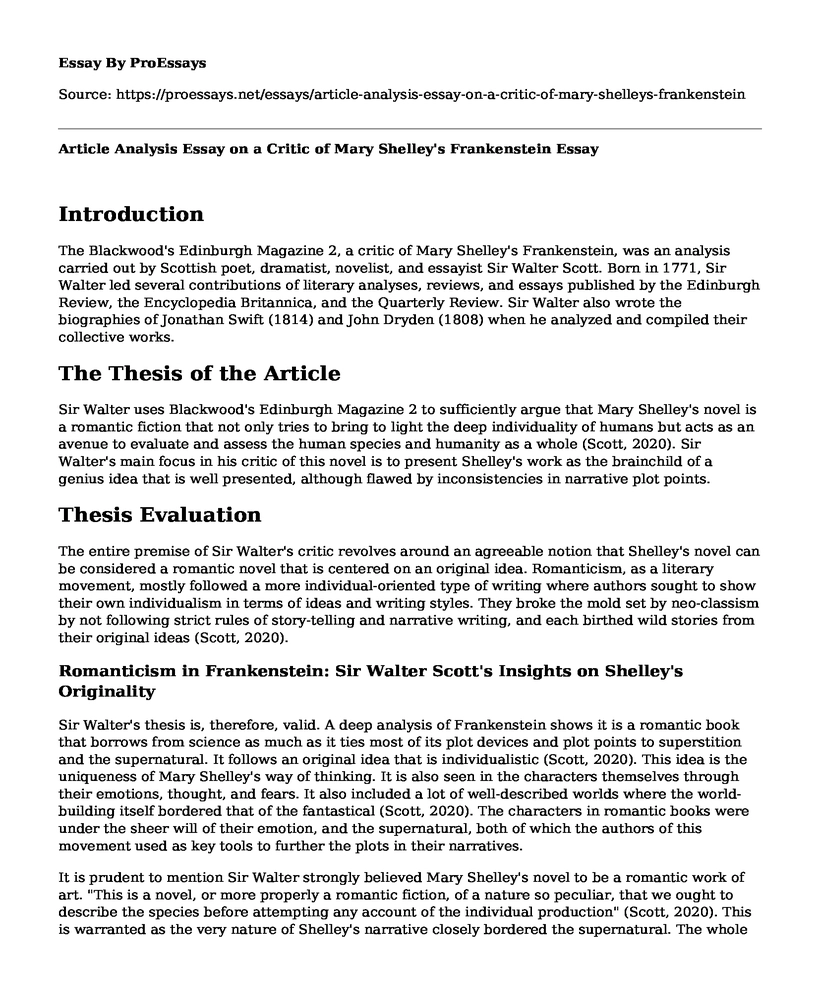Introduction
The Blackwood's Edinburgh Magazine 2, a critic of Mary Shelley's Frankenstein, was an analysis carried out by Scottish poet, dramatist, novelist, and essayist Sir Walter Scott. Born in 1771, Sir Walter led several contributions of literary analyses, reviews, and essays published by the Edinburgh Review, the Encyclopedia Britannica, and the Quarterly Review. Sir Walter also wrote the biographies of Jonathan Swift (1814) and John Dryden (1808) when he analyzed and compiled their collective works.
The Thesis of the Article
Sir Walter uses Blackwood's Edinburgh Magazine 2 to sufficiently argue that Mary Shelley's novel is a romantic fiction that not only tries to bring to light the deep individuality of humans but acts as an avenue to evaluate and assess the human species and humanity as a whole (Scott, 2020). Sir Walter's main focus in his critic of this novel is to present Shelley's work as the brainchild of a genius idea that is well presented, although flawed by inconsistencies in narrative plot points.
Thesis Evaluation
The entire premise of Sir Walter's critic revolves around an agreeable notion that Shelley's novel can be considered a romantic novel that is centered on an original idea. Romanticism, as a literary movement, mostly followed a more individual-oriented type of writing where authors sought to show their own individualism in terms of ideas and writing styles. They broke the mold set by neo-classism by not following strict rules of story-telling and narrative writing, and each birthed wild stories from their original ideas (Scott, 2020).
Romanticism in Frankenstein: Sir Walter Scott's Insights on Shelley's Originality
Sir Walter's thesis is, therefore, valid. A deep analysis of Frankenstein shows it is a romantic book that borrows from science as much as it ties most of its plot devices and plot points to superstition and the supernatural. It follows an original idea that is individualistic (Scott, 2020). This idea is the uniqueness of Mary Shelley's way of thinking. It is also seen in the characters themselves through their emotions, thought, and fears. It also included a lot of well-described worlds where the world-building itself bordered that of the fantastical (Scott, 2020). The characters in romantic books were under the sheer will of their emotion, and the supernatural, both of which the authors of this movement used as key tools to further the plots in their narratives.
It is prudent to mention Sir Walter strongly believed Mary Shelley's novel to be a romantic work of art. "This is a novel, or more properly a romantic fiction, of a nature so peculiar, that we ought to describe the species before attempting any account of the individual production" (Scott, 2020). This is warranted as the very nature of Shelley's narrative closely bordered the supernatural. The whole idea of animating a body in itself is beyond science, and the beautiful, flowery language Shelley uses cement the writing as strictly romantic. By extension, romanticism ties directly to individualism, something that Sir Walter closely ties to Shelley's work.
Mary Shelley's Frankenstein as a Work of Art: Sir Walter Scott's Interpretation
Mary Shelley's work revolves around Dr. Frankenstein's monster, a being that has been animated through science from lifelessness to breath. It is a roller-coaster of events that revolve around these two characters: Dr. Victor Frankenstein and his family as they try to cope with the sudden success of the doctor's attempts at reanimation, and his creation, Frankenstein's monster, as he tries to come to terms with this new concept of living he has been introduced to (Scott, 2020).
Support Evaluation
In Sir Walter's writing in Blackwood's Edinburgh Magazine 2, the theme of individualism is elaborately tackled. Sir Walter effectively begins his thesis by mentioning the fact that the world, characters, and narrative created by Mary Shelley are phenomenal and on its own plane of existence "In this species of composition, the marvelous is itself the principal and most important object both to the author and reader" (Scott, 2020).
The novel itself handles individuality as a theme. Sir Walter discusses the fact that the monster is placed in hiding by Dr. Victor (Scott, 2020). Despite this, the monster "listens through a hole in the wall" and manages to learn much about the world around him. The monster is also distrustful of Dr. Frankenstein because the doctor too engrossed in his scientific pursuits. Individualism under the eye of romantics harkens to not conforming to the set norms of society and humanity as a collective (Scott, 2020). That which makes us unique is what draws and connects us to individuals around us.
Conclusion
Conclusively, even Mary Shelley using the word monster in her work, is not coincidental. The word eludes to someone who is so different from those around him/her that he is considered a tabooed outcast. Out casting someone in this manner gives the outcast a mantle of being solely dependent on himself. This makes him an independent, self-reliant individual. "When I looked around, I saw and heard none like me. Was I the monster, a blot upon the earth from which all men fled and whom all men disowned?"
References
Scott, W. (2020). _Blackwood's Edinburgh Magazine_ Review of _Frankenstein_, 1818 | Romantic Circles. Romantic-circles.org. Retrieved 1 April 2020, from https://romantic-circles.org/reference/chronologies/mschronology/reviews/bemrev.html.
Cite this page
Article Analysis Essay on a Critic of Mary Shelley's Frankenstein. (2023, May 05). Retrieved from https://proessays.net/essays/article-analysis-essay-on-a-critic-of-mary-shelleys-frankenstein
If you are the original author of this essay and no longer wish to have it published on the ProEssays website, please click below to request its removal:
- A Literary Essay: Analysis of Form, Structure and Theme of Death in Selected Poems
- Essay Sample on Development of History Through Writings
- Essay Example on Lestat de Lioncourt: From Lowlife to Beloved Character
- Community, Identity, Stability: Critical Essay on Brave New World
- Essay Example on Animal Farm: Orwell's Satirical Look at the Russian Revolution
- Essay Example on Portraying Culture in Literature: Examining Homer's 'The Odyssey'
- Essay Example on Genni Genn's Versions: A Canadian Novella & Other Stories







